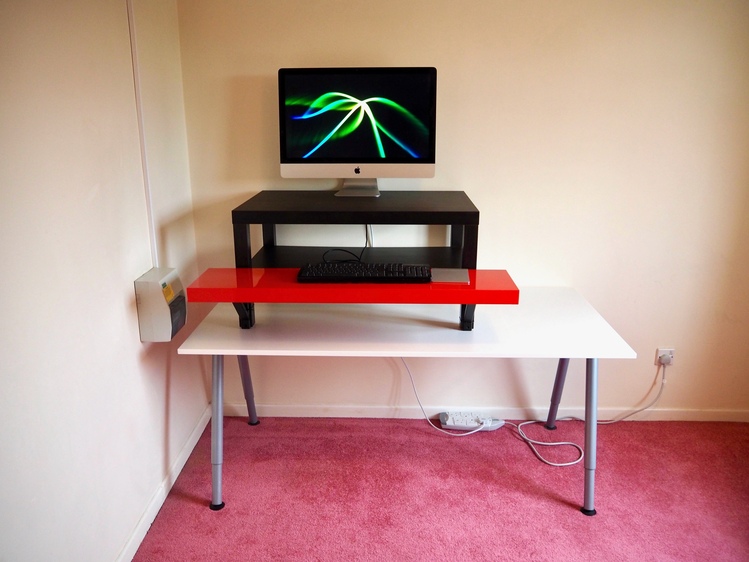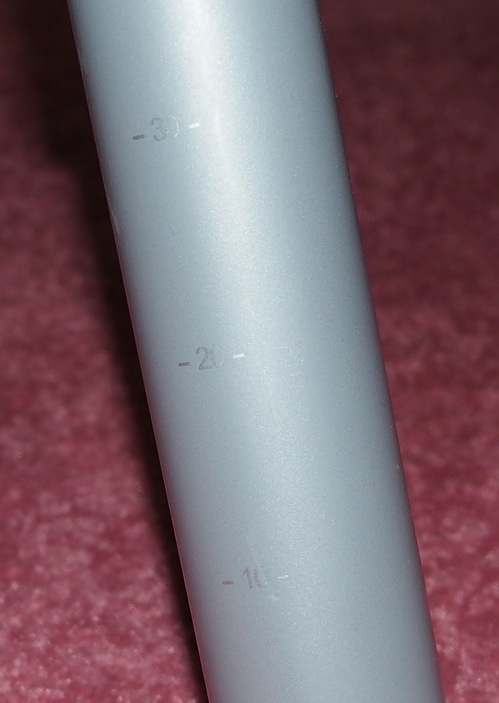My new standing desk
Inspired by Colin Nederkoorn’s $22 standing desk, I decided to have a go at building my own standing desk from IKEA parts when I moved into my new flat. I’ve been using a standing desk for several years, but moving my old desk would have been more hassle than building this new one.
I’ve made a few changes to his design, based partly on personal preference, and partly on the fact that I couldn’t get all of the parts that he used from the British branches of IKEA.
Here’s a picture of the new desk, from the front on:

I particularly liked the black-and-red aesthetic of the “desks in action” shown in Colin’s post, so I decided to mimic that for my desk. I didn’t have an existing desk to build on, so I also had to get a base from IKEA, but even that was fairly cheap.
Here’s the parts list:
| Galant desk | 69 |
| Lack coffee table | 16 |
| Lack wall shelf | 10 |
| Ekby Valter bracket × 2 | 4 |
| Fixa stick-on floor protectors | 0.80 |
| Cable ties | Free |
Overall, you could replicate this setup for just under £100, although the Galant range is about to be replaced, so you’d probably need to find a different base.
Notes on the parts
The Galant forms the base of the desk. There’s a metal bar that runs directly under the centre of the desk top, so it feels nice and solid. One feature I particularly appreciated was that the legs extensions have measurements on them. (They’re quite hard to make out, but this photo shows a 10, a 20 and a 30 mark.)

When I was trying to adjust the height, these markings made it easy to get a consistent extension on each of the legs.
The Lack coffee table was actually a cast-off from my aunt, who was rearranging her living room. Colin used a square Lack, but I prefer this larger size: it feels more substantial, and I have a concealed shelf around keyboard height. I suspect this will get used for external disk drives and the like.
Colin used an Ekby Viktor shelf for his design, but this is only available in black/white in the UK. I wanted the glossy red, so I had to look elsewhere. The Lack wall shelf is the only glossy red shelf sold by Ikea, and this is the smallest size. That partly influenced my decision to go with the larger desk.
One thing I didn’t consider with the glossy shelf is how it would work with my mouse. As it turns out, my laser-guided mouse is baffled by the shiny surface, and I’ve had to switch to a Magic Trackpad for the time being. (More on that shortly.)
Finally, the Ekby Valter brackets are a direct lift from Colin’s design, and they’re attached to the legs of the Lack with some cable ties. I already had a pack lying around, and I’d rather not mutilate the legs of an otherwise good coffee table.
Overall it took less than an hour to put together (including adjusting the height of the Galant), spread over about a week as I gathered all the parts.
All I did was assemble the Galant and the Lack, put the Lack on top, and cable tie the two Valter brackets to the front legs of the Lack. Everything else is loose and adjustable.

The computer is a 27″ iMac that I bought for myself last Christmas. I’m using a Magic Trackpad in place of my usual Magic Mouse. I’ll probably just get a mousemat and go back to a mouse when I have the chance.
The keyboard is a Das Keyboard Model S Ultimate. It’s a mechanical keyboard which I’ve been using for a couple of years. I love the feel, and it makes a delightfully loud clicky sound as I type. But what surprises most people when they see it is that the keycaps are blank. This was intentional: I bought the keyboard this way; they haven’t just rubbed off.
When I bought the keyboard, my schoolwork meant that I was routinely using at least four different keyboard layouts: UK English, German, Greek and Chinese. If I had printed keycaps, then I’d often be pressing a key whose label bore no resemblance to what appeared on the screen. That always felt a little odd to me, so I deliberately bought a keyboard that avoids this problem.
Thanks to Colin for the original design, and giving me the idea!